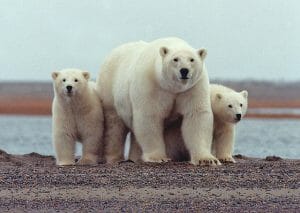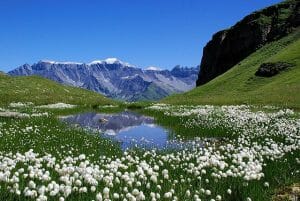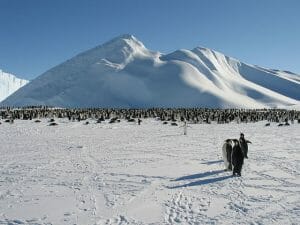The tundra is a biome that does not have many trees because of short growing seasons and low temperatures. The three types of tundra on the Earth are the Arctic tundra, alpine tundra and Antarctic tundra. There are a variety of biotic factors that are characteristic of each type of tundra. Various bacteria and fungi are important biotic factors that are common in all tundra biomes.
Arctic Tundra
Polar bears are one of the most recognizable animals on the Arctic tundra. Other animals include the Arctic fox, the Arctic wolf, reindeer, musk ox, seals, the Arctic hare, the snowy owl and lemmings that live underneath the snow. Peat soils, cotton grass, rushes and mosses like Sphagnum are typical of this area as are willow trees and sunflowers. There are some species of Arctic insects like black flies and mosquitos as well as spiders that have evolved and adapted to the freezing conditions.

The image above shows a mother polar bear Ursus maritimus with her offspring. Polar bears live in the Arctic tundra within the Arctic Circle.
Alpine Tundra
Resident mammals in the alpine tundra include mountain sheep, mountain goats, ibex, chamois, wildcats, marmots, ground squirrels, jumping mice, pikas, rabbits and birds like the snow goose, the ptarmigan and owls. The alpine tundra has few, if any, trees because the altitude and soils do not support their growth. The few spruce, fir, pine and willow that live in the transitional area (about 330 feet higher than the lower forest areas) are stunted in their growth and scattered around. Other plants in the alpine tundra are cotton grass, lousewort and various shrubs. Alpine insects include black flies and mosquitos.

The image above shows the alpine tundra area of Glarus, Switzerland.
Antarctic Tundra
Seals are one of the few mammals that live on the Antarctic tundra due to the physical isolation of the area that has occurred over millions of years. Adélie and Emperor penguins and seabirds like petrels, terns and gulls populate the area. Survival is challenging for plants on the Antarctic tundra, but there are close to 400 species of lichens, 25 liverworts, 100 mosses, about 700 species of algae and two species of flowering plants (Antarctic hair grass and Antarctic pearlwort) that have adapted to live in the rockier areas of the biome. The Antarctic midge is the only insect that lives on the continent.

The image above shows Emperor Penguins Aptenodytes forsteri on the Antarctic tundra.
References
- Tundra. (n.d.). In Wikipedia. Retrieved July 11, 2017 from https://en.wikipedia.org/wiki/Tundra
- Tundra. (2017, July 11). In Encyclopedia Britannica online. Retrieved from https://www.britannica.com/science/tundra
